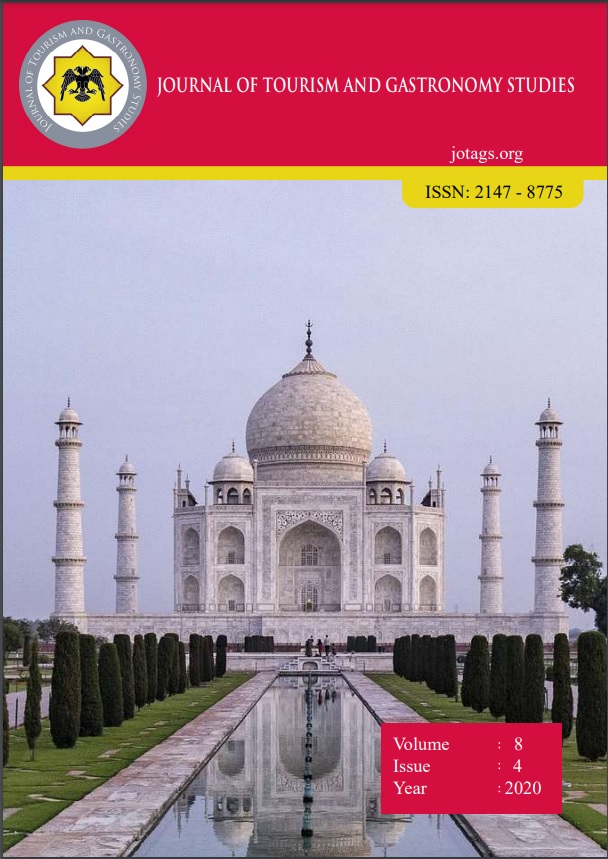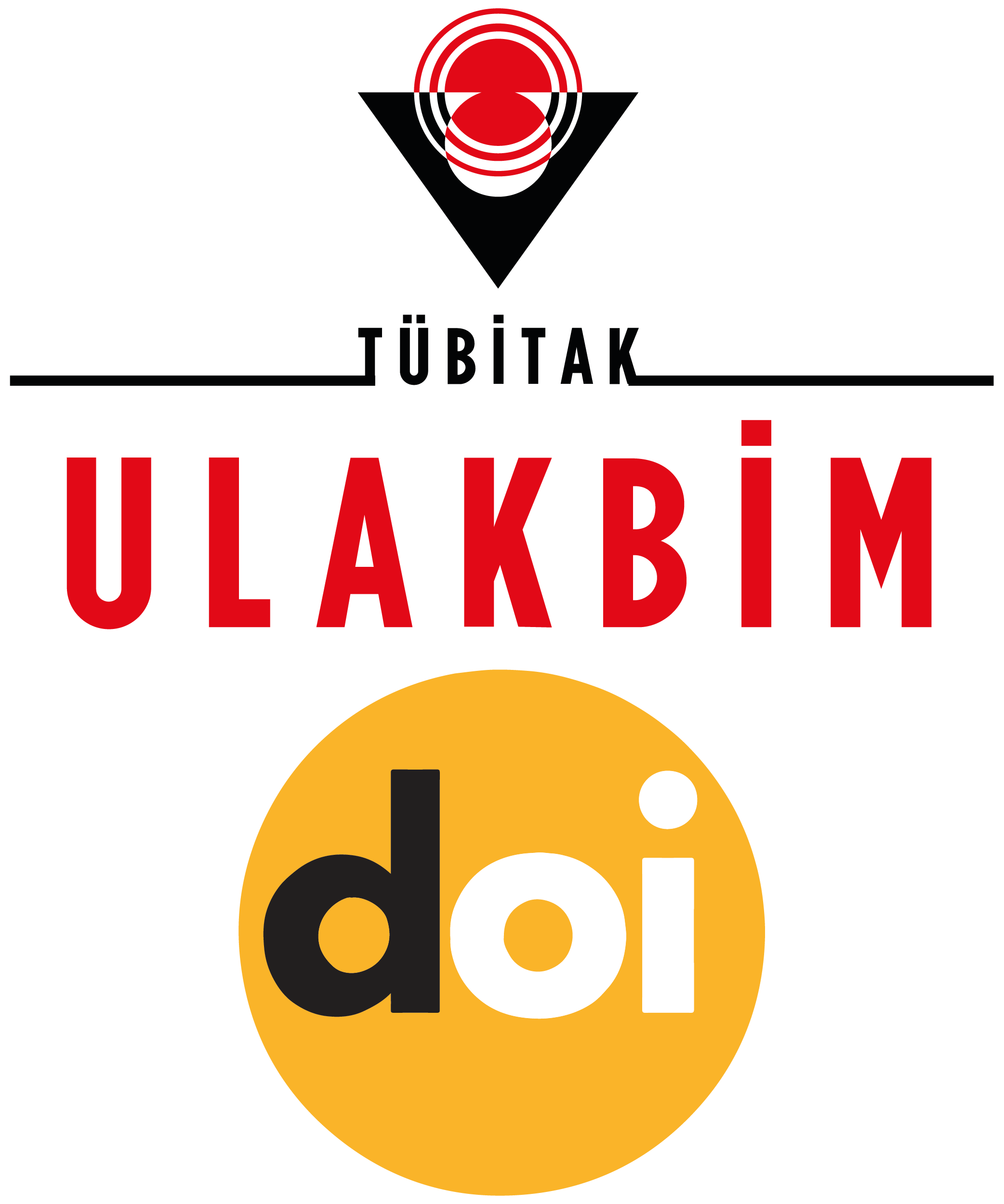Turizm İşletme Belgeli Restoranlarda Çalışanların Paraya Yönelik Tutumlarının Duygusal Bağlılık Üzerine Etkisi (Effect of Attitude Toward Money on Affective Commitment of Employees in Tourism Certificated Restaurants)
DOI:
https://doi.org/10.21325/jotags.2020.737Keywords:
Tourism certificated restaurant, Attitude towards money, Affective commitmentAbstract
The purpose of this study is to determine the effect of the attitudes towards money of the employees working in tourism certificated restaurants on their affective commitment levels. In the study, which has a descriptive model, the survey technique was used as a data collection tool. The questionnaire form consists of 3 parts, the first part includes demographic information, the second part includes the scale of attitude towards money, and the third part includes the affective commitment scale. The sample of the research consists of 439 employees working in tourism certificated restaurants between September-October 2019. Statistical analysis techniques such as frequency, reliability, factor and regression were applied to the data obtained from the research. The findings of the regression analysis show that, the attitude towards money of the employees participating in the research has a negative and medium level effect on their affective commitment levels. Accordingly, it was found that as the attitude towards money increases in restaurant employees, the level of affective commitment decreases.
References
Abdullah, N., Fazli, S.M., & Arif, A.M.M. (2019). The relationship between attitude towards money, financial literacy and debt management with young worker’s financial well-being. Pertanika Journal of Social Sciences & Humanities. 27(1): 361-378.
Ahmad, R., & Scott N. (2015) Fringe benefits and organisational commitment: The case of Langkawi hotels. Tourism Review, 70(1): 13-23.
Akgül, A., & Çevik, O. (2005). İstatistiksel analiz teknikleri “SPSS’te işletme yönetimi uygulamaları”. Ankara: Emek Ofset.
Aktuna, H.C., & Kılıçlar, A. (2020). Örgütsel adaletin örgütsel sinizm üzerindeki etkisi: Paraya yönelik tutumun düzenleyici rolü. Journal of Tourism and Gastronomy Studies. 8(2): 1457 – 1484.
Allen, N.J., & Meyer, J.P. (1990). The measurement and antecedents of affective, continuance and normative commitment to the organization. Journal ofOccupational Psychology, 63(1): 1-18.
Aren, S. (2008). İstihdam para ve iktisadi politika. Ankara: İmge Kitabevi.
Ariffin, H.D., & Che Ha, N. (2014). Examining Malaysian hotel employees organizational commitment: The effect of age, education level and salary. International Journal of Business and Technopreneurship. 4(3): 413-438.
Arslan, E. (2020). Çalışanların paraya olan tutum, kariyer bağlılığı ve kariyer tatmin düzeyleri arasındaki ilişki: Otel işletmelerinde bir araştırma, İşletme Araştırmaları Dergisi. 12(2): 1475-1488.
Balay. R. (2000). Yönetici ve öğretmenlerde örgütsel bağlılık. Ankara: Nobel.
Brien, A., Thomas, N., & Hussein, A.S. (2015). Turnover intention and commitment as part of organizational social capital in the hotel industry. Journal of Human Resources in Hospitality & Tourism,14(4): 357-381.
Büyüköztürk, Ş. (2008). Veri analizi el kitabı. Ankara: Pegem Yayınları
Chui, C.T.B., & Sidin, S.M. (2011). Satisfying women’s status desires role of money attitude and consumer vanity in status consumption. Advances in consumer research. Asian Pacific Conference Proceedings. 9(1): 355-362.
Eroğlu, A. (2009). Faktör analizi. (Ed: Kalaycı, Ş.) SPSS uygulamalı çok değişkenli istatistik teknikleri içinde (ss. 403-419) Ankara: Asil Yayın Dağıtım
Furnham, A. (1996). Attitudinal correlates and demographic predictors of monetary beliefs and behaviors. Journal of Organizational Behavior. 17: 375 – 388.
Güzel, B. (2009). Kadın çalışanların kariyer engellerinin örgütsel bağlılık üzerine etkisi: Dört ve beş yıldızlı otel işletmelerinde bir uygulama (Doktora Tezi). Dokuz Eylül Üniversitesi, Sosyal Bilimler Enstitüsü, İzmir.
Kayış, A. (2009). Güvenirlik Analizi. (Ed: Kalaycı, Ş.) SPSS uygulamalı çok değişkenli istatistik teknikleri içinde (ss. 403-419) Ankara: Asil Yayın Dağıtım
Korkmaz, O., & Erdoğan, E. (2014). İş yaşam dengesinin örgütsel bağlılık ve çalışan memnuniyetine etkisi. Ege Akademik Bakış, 14(4): 541-557.
KTB. (2019). Kültür ve Turizm Bakanlığı Yatırım İşletmeler Genel Müdürlüğü, Turizm Tesisleri. https://yigm.ktb.gov.tr/TR-9579/turizm-tesisleri.html. Erişim Tarihi: 07.10.2019.
Leung, M., Chen, D., & Yu, J. (2008). Demystifying moderate variables of the interrelationships among affective commitment, job performance, and job satisfaction of construction professionals. Journal Of Construction Engineering And Management, 134(12): 963-971.
Maxwell, G., & Steele G. (2003). Organizational commitment: A study of managers in hotels. International Journal of Contemporary Hospitality Management, 15(7): 362- 369.
Meyer, J.P., & Allen, N.J. (1984). Testing the side-bet theory of organizational commitment: Some methodological implications. Journal of Applied Psychology, 69(3): 372- 378.
Meyer, J.P., & Allen, N.J. (1991). A three-components conceptualization of organizational commitment. Human Resource Management Review. 1(1): 61-89.
Mitchell, T. R., & Mickel, A. E. (1999). The meaning of money: An individual – difference perspective. Academy of Management Review. 24(3): 568 – 578.
Mowday, R.T., Steers, R.M., & Porter. L.W. (1979) The measurement of organizational commitment. Journal of Vocational Behavior, 14(22): 224- 247.
O’Reilly, C., & Chatman, J. (1986). Organizational commitment and psychological attachment: The effects of compliance, identification, and internalization on prosocial behavior. Journal of Applied Psychology, 71(3): 492- 499.
Paya, M.M. (1994). Para teorisi ve para politikası. İstanbul: Filiz Kitabevi.
Price, D.Z. (1968). A technique for analyzing the economic value system. Journal of Marriage and the Family, 30(3): 467-472.
Simons, T., & Hinkin, T. (2001). The effect of employee turnover on hotel profits: A test across multiple hotels. Cornell Hotel And Restaurant Administration Quarterly, 42(4): 65-69.
Randall, D.M. (1990). The consequences of organizational commitment: Methodological investigation. Journal Of Organizational Behavior. 11: 361-378.
Roberts, J., & E. Jones. (2001). Money attitudes, credit card use and compulsive buying among american college students. The Journal of Consumer Affairs, 35(21): 213-240.
Rose, G.M., & Orr, L.M. (2007). Measuring and exploring symbolic money meanings. Psychology & Marketing, 24(9): 743-761.
Süer, Ö., Baklacı, H.F., & Kocaer, E. (2017). Para tutumunun kariyer hedefleri üzerindeki etkisi: Üniversite öğrencileri üzerinde bir araştırma. Ege Akademik Bakış, 17(4): 527-537.
Tabachnick, B., & Fidell, L. (2013). Using Multivariate Statistics (Sixth Edition). Pearson Education, United States.
Tang, T.L-P. (1992). The meaning of money revisited source. Journal of Organizational Behavior. 13(2): 197-202.
Tang, T.L-P. (1995). The development of a short money ethıi scale: Attitudes toward money and pay satisfaction revisited. Personality and Individual Differences, 19(6): 809-816.
Tang, T.L-P., Arocas, R.L., & Whiteside, H.D. (1997). Attitude toward money and demographic variables as related to income and life satisfaction: US vs. Spain, 22. Annual Conference of International Association for Research in Economic Psychology, Valencia, Spain, September 15-18.
Tang, T.L-P., Kim, J.K., & Tang, D.S-H. (2000). Does attitude toward money moderate the relationship between intrinsic job satisfaction and voluntary turnover? Human Relations. 53: 213-245.
Tekingündüz, S. (2012). Örgütsel bağlılık üzerinde örgütsel güven ve iş tatmininin etkisinin belirlenmesine yönelik bir alan çalışması (Doktora Tezi). Gazi Üniversitesi, Sosyal Bilimler Enstitüsü, Ankara.
Tett, R.P., & Meyer, J.P. (1993). Job satisfaction, organizational commitment, turnover, ıntention and turnover: Path analysis based on meta-analytic findings. Personnel Psychology, 46(2): 259-293.
TOBB. (2017) Türkiye Odalar ve Borsalar Birliği & Türkiye Otelciler Federasyonu (TÜROFED), Turizm Sektör Meclisi: Turizm Raporu 2016. URL: https://www.tobb.org.tr/Documents/yayinlar/2015/TURIZM16/files/assets/common/downloads/publication.pdf. Erişim Tarihi: 28.09.2019.
Ural, A., & Kılıç, İ. (2006). Bilimsel araştırma süreci ve SPSS ile veri analizi. Ankara: Detay Yayıncılık.
Ünlüönen, K., & Arslan, E. (2012). Otel işletmelerinde çalışanların paraya olan tutumunun mesleki etik değerler açısından incelenmesi. Elektronik Sosyal Bilimler Dergisi. 11(40): 173-187.
Wahn, J.C. (1998). Sex differences in the continuance component of organizational commitment. Group and Organization Management, 23(3): 256-266.
Williams, L.J., & Hazer, J.T. (1986). Antecedents and consequences of satisfaction and commitment in turnover models: A reanalysis using latent variable structural equation methods. Journal Of Applied Psychology, 71: 219-231.
Yamane, T. (2001). Temel örnekleme yöntemleri. (1. Baskı). (Çev. Esin, A., M. A. Bakır, C., Aydın & E. Gürbüzsel). İstanbul: Literatür Yayıncılık.
Yousef, A. (2016). Organizational commitment, job satisfaction and attitudes toward organizational change: A study in the local government. International Journal of Public Administration, 39(6): 1-12.
Downloads
Published
How to Cite
Issue
Section
License
Copyright (c) 2023 Journal of Tourism & Gastronomy Studies

This work is licensed under a Creative Commons Attribution-NonCommercial 4.0 International License.








